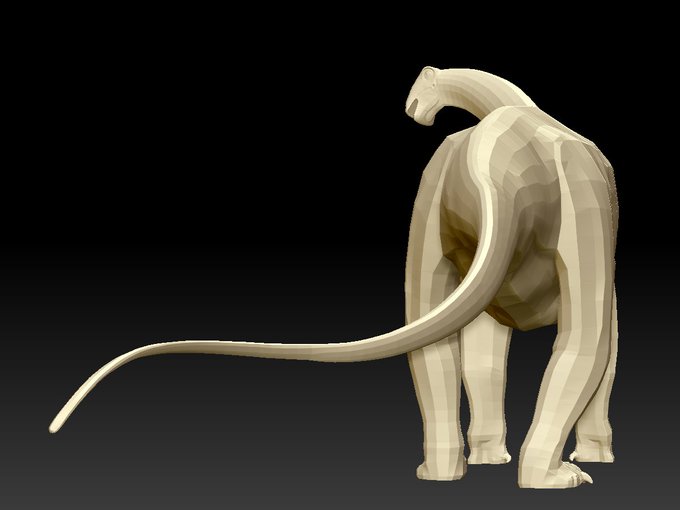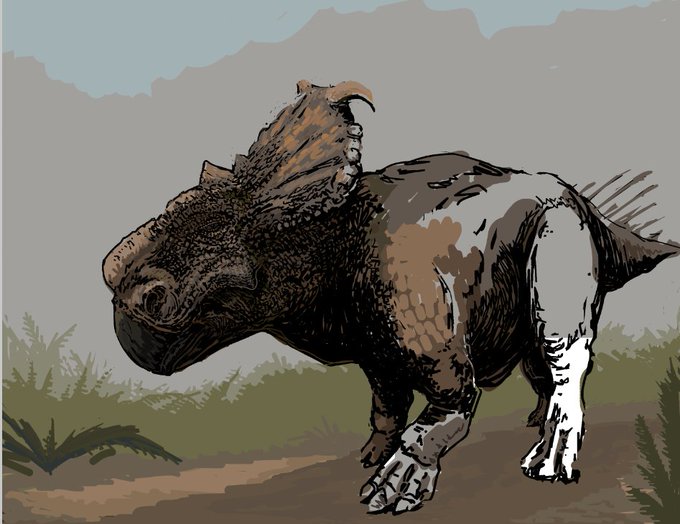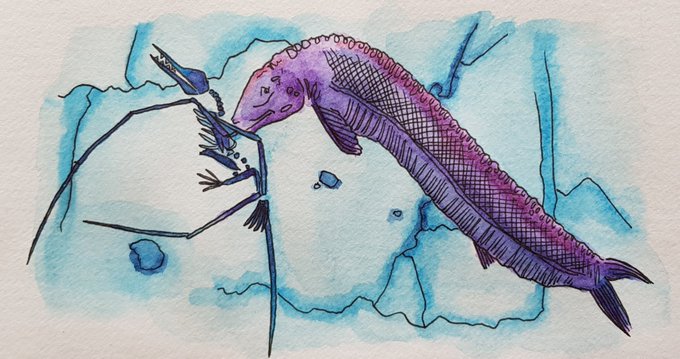fossilfridayのTwitterイラスト検索結果。 1,036 件中 35ページ目
Some Mosasaurus #paleoart for #FossilFriday. And no, we don't know that they had dorsal fins, but we don't know that they didn't either - the right parts of their soft tissues have not, to my knowledge, been preserved to indicate either way.
This #FossilFriday we're loving 😍 the beautiful illustrations of Liassic fossils from Stanford's Geological Atlas of Great Britain, 1904. #maps
Happy #ValentinesDay/#FossilFriday! We still don’t know how Radiodonts reproduced, but it probably started (at least in some species) during mass-moulting events, when large numbers of them got together to moult. See fossils of #Cambroraster, for example. (1/2)
#Paleontology
Some new #paleoart for #FossilFriday: my take on Yutyrannus published in entirety for the first time this week. It was created for LTTAII, but that's coming out soon enough to let the covers slip a little on the art. A short thread about this image...
Australopithecus boisei was so romantic 1.6 million years ago, that its spinal cord exited the skull through a heart-shaped foramen magnum #ValentinesDay #FossilFriday
Nenúfares. An Unenlagiine in its pond. Some old art for this #FossilFriday #scicomm #palaeoart
Time to briefly revisit Elrhaz Formation with this #Nigersaurus taqueti model. Original reconstruction of this animal was among the first sauropods ever portrayed with a form of "beak" at the tip of the jaws.
#3Dmodeling #zbrush #dinosaurs #FossilFriday
As it's #FossilFriday I took a punt at a Pachyrhinosaur...
(apologies to actual #paleoart / #paleontology people, for any horrific amateur mistakes I've blundered into - feel free to correct if I've disgraced current finds in some way, I'll bare in mind for future)
#dinosaurs
O is for Oohkotokia. A 74 million year old anklyosaur. The name is in honour of the native Niitsitapi people in North America, who's land it was found on. #FossilFriday
(Photo, Paul Penkalski; Art, DevianArt: Ciciopurple)
As I recover from my wisdom tooth extraction on #FossilFriday, I was reminded of this amazing fossil shark from Peru in the collections of @FloridaMuseum. I don't know why.
You can read more about the discovery here: https://t.co/sVIZ6qvJ8i
In Anth 211 this week, students will try to virtually reconstruct the Nariokotome Homo erectus cranium, based on the individual bones they digitized last week #FossilFriday
As voted earlier this morning, here is my sketch/speedpaint today: the large, big headed stem-tetrapod Crassigyrinus scoticus. My entry for today’s #FossilFriday There are two Crassigyrinus here #paleoart #sciart
The primates in PALEOCENE aren't based on a known fossil species, but are hypothetical ancestors of tarsiers and monkeys. They'd be similar to this Archicebus (illustration by Mat Severson, CC-BY-SA 4.0 license). #FossilFriday
The second article all about the #evolution of #flight. This time taking a look at the first #vertebrates to take to the skies. #UnlockingThePast this #FossilFriday with the #Pterosaurs: https://t.co/WZZAkPw9Ft
#Eudimorphodon #palaeoart by @TheWoodParable
E is for Euoplocephalus. It's name literally means 'well-armoured head'. And it was. This anyleosaurid giant, was tail whipping and head butting in Canada around 80 million years ago. #FossilFriday
(Photo Victoria Arbour & Philip Currie; Art John Sibbick)
Progress on the #Iguanodon tonight. Looking good. #sciart #paleoart #fossilfriday #dinosaurs
For #FossilFriday I'll share one of my favourite fossils:
Rhamphorhynchus flies over water.
Snap! Catches a fish.
Then (there's always a bigger fish) SNAP! get's caught by a Aspidorhynchus leaping out the water! But it's too chewy, entangles with the teeth! Oh no, all die!
For #FossilFriday a species I am working with right now! Ampelomeryx is a kind of "#punk #giraffe" with several ossicones that lived in Europe 18Mya. It possesses #sabertooth ... YES a punk giraffe with sabertooth !!!
#weloveruminants #fossils #mammals #paleontology
#3January #January3 #3Gennaio 2020
Carcharocles angustidens🦈
"There were no human beings to devour when this mighty relative of the existing white shark swam the seas"
D. Bashford - The Department of Fishes, American Museum
Natural History V. 23 (1923)
#fossils #fossilfriday
First #fossilfriday of the year. Not a sketch today, but a photogrammetry of the trilobite Crozonaspis struvei I did for my final essay of Invertebrates Palaeontological. Not the best specimen, but you can see most it's cephalon features, including the cool tiny eye lenses!















































